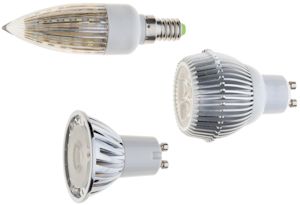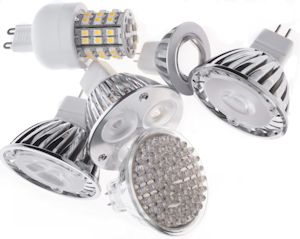FAQ - Types of residential LED lights
Overview
LED lights now come in a vast array of different fittings, colours, sizes & output levels. There are now lights available for almost any circumstance. On the page we look at the 3 main choices for household lighting.

High voltage retrofit LED lights
Voltage level: 110V or 230V, depending on what country you live in.
Current: Alternating (AC).
Fitting types: GU10, Bayonet B22, E27/E26 Edison.
LEDs by their nature run on low voltage direct current (DC). So connecting a LED light to 110V or 230V AC supply might not seem like the natural option. These high voltage lights exist primarily because most of the existing residential lighting in the world is wired up at mains voltage. Inside the globe itself there is a rectifier circuit which provides a regulated current output at lower voltage DC. The great advantage of this type of solution is that no external transformer or 'driver' is required. This can reduce maintenance & cost.

Low voltage retrofit LED lights
Voltage level: 12V
Current: Alternating (AC).
Fitting types: MR16.
These low voltage lights exist primarily because over the last couple of decades millions of low voltage downlights were installed around the world. These were normally power hungry halogen lights. So there is a large market to retrofit these halogen lights with LED lights. These lights would normally use external transformers to lower the voltage to 12volts AC. Having an external transformer means the LED light can be slightly smaller and run cooler, as the transformer would output some of the heat lost in the conversion process. In some cases it might be possible to use your existing transformers in other cases new transformers may be required. If new transformers are required, then it might make sense to convert the MR16 fitting into a GU10 high voltage fitting or a dedicated LED fitting. You would not normally use this option for a new lighting installation. Inside the globe itself there is a rectifier circuit which converts low voltage AC into low voltage DC. So like the high voltage option above the light contains some electronics.

Low voltage Dedicated LED lights
Voltage level: 5V to 48V
Current: Direct (DC).
Fitting types: Various.
Dedicated LED lights. Normally used for a new lighting installation where there are not existing fittings. Typically these kits are hard wired with a special transformer (known as a driver) which is supplied with the light. The driver will be carefully matched to the light and typically can't be reused with a different light. The driver outputs regulated low voltage DC, which means that the LED chip in the light will likely last longer and that no electronics will be required in the light itself. LED lights tend to get hot when in use, so keeping the driver external to the light means keeps the electronics cooler, which is a good thing and should in theory make the whole system more realiable. In many cases the kit might be terminated in the two pin plug, for connection to a standard mains socket in the ceiling, making replacement of faultly lights less painful than it might appear.
Other solutions
There are a collection of other LED solutions. Including strip lighting, light panels and fluorescent tubes replacement options. At the moment we aren't looking at the performance of these slightly less common solutions, so they aren't covered here.
What's the best option
In our opinion the MR16 fitting with 12V AC will slowly die out over time, but if you already have this in place there will be retrofit solutions available for many years to come. Fittings that use mains voltage will be around forever as it is by far the simplest option. Dedicated LED lights will gain in popularity for new installations, particularly in situations where the highest level of efficiency and reliability is required.Back to FAQ index